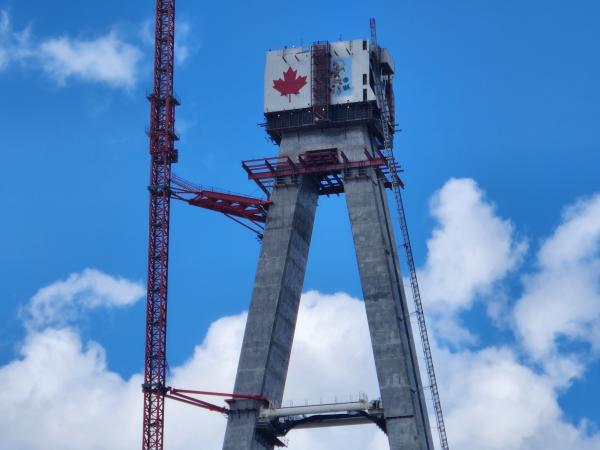
Visible at key vantage points throughout Windsor and Detroit, the distinctive tower legs of the Gordie Howe International Bridge are an engineering marvel. Currently standing at approximately 152 metres/500 feet and exceeding the height of any structure in the City of Windsor, and taller than the Statue of Liberty in the United States, the tower legs are a stunning example of the progress made to date and what is to come on this iconic project.
Now, the magnitude of their full 220 metres/722 feet is that much closer to reality.
Bridging North America (BNA), Windsor-Detroit Bridge Authority’s (WDBA) private-sector partner, has completed their work to connect the tower legs in both the US and in Canada with concrete transition areas that are approximately 330 cubic metres or 432 cubic yards in size.
“Completing the transition area is a momentous achievement in the construction sequence for the bridge towers,” says Bryce Phillips, WDBA’s CEO. “The project team can now begin work on the third and final stage of the towers.”
A closer look at the towers
Each bridge tower will form an inverted “Y” shape once complete, beginning with two separate legs that make up the lower pylon and connecting about two-thirds of the way up to form the pylon head.
There are three primary phases of construction to create the final bridge towers. First is the underground work for leg support, which BNA completed in 2020. Second is the lower pylon work completing the two separate legs, which wrapped up in March 2022. Finally, the third phase is the upper part of the tower, known as the pylon head. The towers are expected to be fully constructed in 2023.
The transition area was a crucial stage in the construction process and was needed before work crews could continue building up. Transitioning from the lower pylon to the pylon head involved modifications to the jump form systems and concrete pours to construct the upper cross beam that merged the tower legs into a single structure. With that complete, construction can begin on the pylon head which will measure 80 metres/262 feet in height. Critical to the cable-stayed installation works, anchor boxes within the pylon head will house the cables that will connect the towers to the bridge road deck segments.
“It’s an exciting time as we enter the final build phase, for the towers,” says Michael Hatchell, the CEO of BNA. “With the transition area done, the project team is ready to bring the bridge towers to their final 220 metres/722 feet height.”
By the numbers – Transition area
- Canada:
- 330 cubic metres/432 cubic yards of concrete
- 287 tonnes/547,000 pounds of rebar
- 6.66 metres/21.85 feet high
- To date, the bridge tower is 150.55 metres/493.93 feet high
- US:
- 319 cubic metres/418 cubic yards of concrete
- 279 tonnes/557,000 pounds of rebar
- 6.66 metres/21.85 feet high
- To date, the bridge tower is 154.62 metres/507.28 feet high


